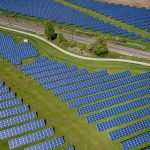How efficient are solar panels? How can their efficiency improve? Besides their benefits, what are the ecological impacts of solar energy?
What Are Solar Panels and Why They’re Growing Globally
Solar panels, also known as photovoltaics – which means “light-electricity” – are devices that convert sunlight into electricity. A solar panel is a collection of small silicon-based solar cells which have conductive properties which set electrons into motion and convert sunlight into electricity.
Over the past 20 years, the costs associated with solar cells have been steadily decreasing. In fact, according to the International Renewable Energy Agency (IRENA), solar PV module prices have fallen by around 80% since the end of 2009. Price shortfalls and economic gains, together with the urgency to design more ecological and resilient societies led to the growth of renewables, and solar energy, in particular, across electricity grids worldwide.
However, and despite their benefits – which make them a far more ecological option than fossil-fuels – solar energy is not perfect, as we’ve highlighted in our piece: Is Solar Energy Really Green And Sustainable? Put simply, manufacturing photovoltaic panels can consume a lot of energy and requires finite Earth minerals that have harsh extraction impacts, apart from the many questions still in the air regarding their recycling.
However, there is also another topic we feel should be analyzed in greater detail: the lack of efficiency of solar panels. How efficient are solar panels?
How Efficient Are Solar Panels?
Before answering this question it is important to make sure we are all on the same page regarding what efficiency means within the specific context of solar energy. In this way, efficiency can be understood as to how good the solar panel is at transforming the Sun’s light into electricity.
In other words, a panel with 100% efficiency would be one that’s able to transform all the light that hits the panel to electrical energy. Scientists define solar efficiency as the ratio of how much power the solar panel generates considering how much power it gets from the Sun.
A solar panel’s efficiency depends on different variables such as temperature, shade, orientation, and the type of solar cells. The latter is, however, the one needing greater improvements as all the other variables are easier to control. But why?
The Average Solar Panel Silicon Cells Are Not Very Efficient
The semiconductors that convert sunlight into electrical energy are seen as inefficient as they only capture a fraction of the light they get. Sunlight spans a broad spectrum of wavelengths, and depending on the characteristics of the semiconductor and the design of the cell, some of that light is reflected, some passes through, and some gets absorbed but converted into heat before the energy can be used.
Today’s typical silicon solar cell panels operate at around 22% efficiency, while the best silicon solar cell reached a 26.7% efficiency on a lab scale. For this reason, many modern solar research projects are focused on figuring out and designing more efficient sunlight conductors. These new cells must have a higher conversion efficiency, or, in other words, they must be able to convert a greater fraction of incoming sunlight into electrical energy.
Recent development point out a new promising kind of semiconductors: perovskites. Perovskites are at the center of an effort to develop a new generation of thin-film solar cells that seem to be not only more efficient but also cheaper than today’s silicon solar cells.
Perovskites and the Hopes to Improve Solar Energy Efficiency
The perovskites the solar industry is interested in are “lab-made” rather than mined from the Earth. These synthetic perovskites are made from a mix of organic compounds, metals, and halides (reactive elements). Thanks to their unique structure and chemical composition, they’re great at absorbing sunlight.
By adding perovskites (which can be applied to any flexible surface using a special ink) to traditional silicon cells, the sensitivity of solar panels’ to different parts of the solar radiation spectrum increases. As such, efficiency can be boosted further to overcome the theoretical power conversion efficiency limit of 33%, Wayne Hicks and Don Gwinner from NREL tell.
In fact, Oxford PV, a U.K. company developing solar cells that uses perovskite, announced in December they had reached a (record) 28% conversion efficiency for its tandem perovskite-based solar cell. Moreover, as said in the video above, the mass production of perovskite cells seems to be potentially cheaper and less harmful than producing silicon.
In the end, solar panels are an amazing technology and a great alternative to fossil fuels, but we need to work out how to make them more efficient. Research on alternative designs for more efficient and less expensive solar cells is likely to continue and other alternatives to silicon are expected to show up.
[Photo by Andreas Gücklhorn on Unsplash]

